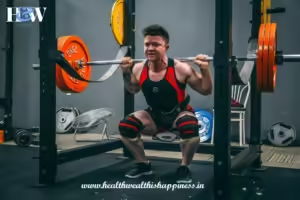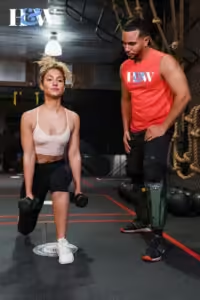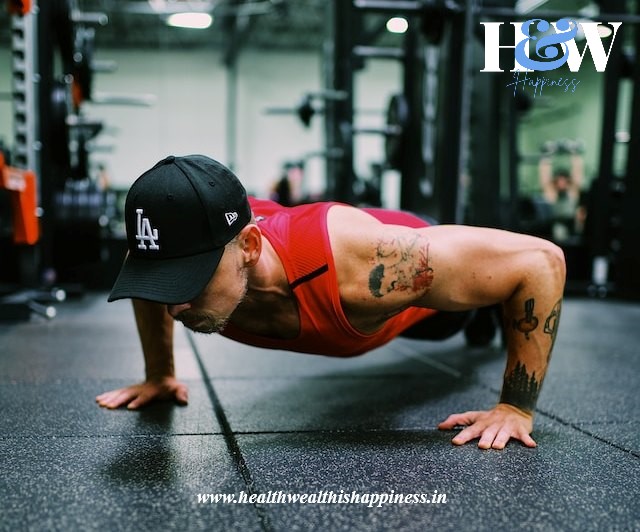Week Day – 6
(Ultimate Leg Workout Guide) Leg workouts are typically overlooked in terms of fitness. Many people overlook the lower body’s power, focusing instead on upper body exercises in an attempt to achieve toned arms and abs. A comprehensive leg exercise program is necessary for general strength, stability, and sports performance. This book will cover the value of leg workouts, efficient workouts, and strategies for making the most of your leg day.
Why Focus on Leg Workouts?
- Base of Strength: The quadriceps, hamstrings, glutes, and calves are among the largest muscles in the body and are located in your legs. Increasing the strength of these muscles benefits the entire body, improving performance in daily tasks and other workouts.
- Enhanced Athletic Performance: Having strong legs is essential for everyone who plays basketball, runs, or simply visits the gym occasionally. They supply the energy required for rapid direction changes, jumping, and sprinting.
- Enhanced Metabolism: Exercises that target the legs burn a lot of calories. Because they use more energy, large muscle groups increase your metabolism and help you lose weight.
- Injury Prevention: Strong legs lower the chance of injury by improving joint stability, especially in the knees and ankles.
- Functional Fitness: Having a strong lower body makes daily tasks like walking, climbing stairs, and lifting goods simpler.
Structuring Your Leg Workout

For a leg workout that works, think about this structure:
- Warm-Up: To improve blood flow and loosen up your muscles, begin with a vigorous warm-up. Exercises like bodyweight squats, high knees, and leg swings can be included in this.
- complex Exercises: Start with complex exercises such as deadlifts and squats. These exercises are great for beginning your workout because they train many muscle groups and demand more energy.
- Isolation workouts: After that, perform isolation workouts such as calf raises, leg extensions, and curls. By concentrating on particular muscles, these workouts let you address any imbalances or inadequacies.
- Cool Down: To increase flexibility and lessen discomfort in your muscles, end your workout with a static stretching session.
Essential Leg Exercises
Squats

- Advantages: Squats work the quadriceps, hamstrings, glutes, and core. They are a basic exercise pattern. They improve stability and total leg strength.
- How to Execute: Position your feet shoulder-width apart, with your toes pointing slightly outward. As though you were sitting in a chair, lower your body by bending your knees and pushing your hips back. Maintain an upright posture with your back straight. Drive through your heels to get back to where you were.
Lunges

- Advantages: Lunges enhance balance and coordination while targeting the quadriceps, hamstrings, glutes, and calves.
- How to Do It: Take a single stride forward, dropping your hips until your knees are bent 90 degrees. Make sure your rear knee is hovering just over the floor and your front knee is just above your ankle. Repeat with the second leg after pushing yourself back up to the starting position.
Deadlifts

- Advantages: Deadlifts are a great way to strengthen your lower back, glutes, and hamstrings.
- How to Execute: Stand with a barbell or dumbbells in front of you and your feet hip-width apart. To catch the weight, bend your knees slightly and hinge at the hips. Maintaining a flat back, lift the weight by straightening your hips and knees. Controllably return the weight to the ground.
Leg Press

Advantages: By isolating the quadriceps, hamstrings, and glutes, the leg press machine enables you to safely lift larger weights.
How to Execute: Place your feet shoulder-width apart on the platform and take a seat on the leg press machine. Stretch your legs to push the platform away, and then slowly take a step back to where you were before.
Calf Raises
Advantages: Calf strengthens the muscles in the calves that are essential for running and jumping, the gastrocnemius and soleus.
How to Do It: Take a stand with your heels hanging off the edge of a step or platform. As high as you can manage, lift your heels and then bring them back down.
Tips for Maximizing Your Leg Workout
- Proper Form: Never choose proper form above heavy weights. This reduces the risk of injury and ensures that the muscles being targeted are being treated efficiently.
- Progressive Overload: Increase the weight or intensity of your workouts gradually to maintain the growth of muscular mass and strength.
- Rest and Recovery: Take adequate breaks between leg workouts to allow your muscles to heal. This usually means that before you train the same muscle group again, you give it another 48 to 72 hours off.
- Nutrition: Give your body the things it needs, such protein to rebuild muscles and carbs for energy.
- Variation: Include a range of exercises and variations in your workouts to keep your muscles challenged and your sessions interesting.
Example Leg Workout Warm-Up: Dynamic stretching for five to ten minutes
Exercise:
Squats: 3 sets of 10–12 repetitions
Deadlifts: 8–10 repetitions in 3 sets
Lunges: 12 repetitions per leg, 3 sets
Three sets of ten to twelve leg presses
Leg raises: three sets of 15–20 repetitions
Cool Down: Static stretching for five to ten minutes
Conclusion
Regularly engaging in a comprehensive leg workout routine is crucial for overall health and fitness. Strong legs provide a solid foundation for daily activities, athletic performance, and injury avoidance. By including a variety of activities and using the right training strategies, you may build strong, resilient legs that will support your fitness goals for years to come. Remember that even though leg day can be difficult, the results are valuable. Get to the gym, put on your sneakers, and take on the challenge of leg workouts!


